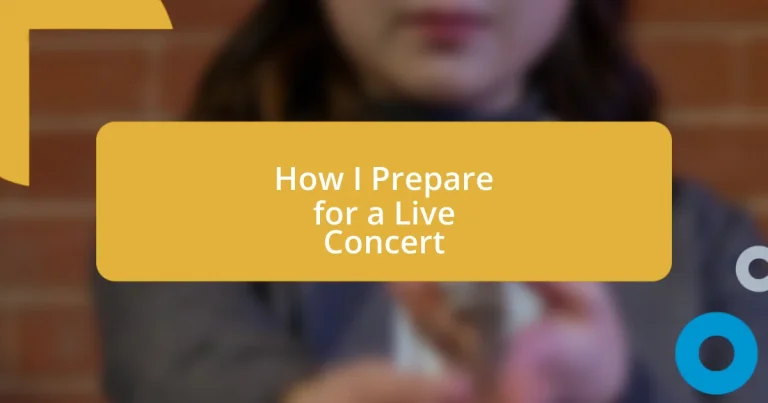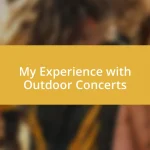Key takeaways:
- Mental and emotional preparation, including setting realistic and flexible goals, is crucial for a successful concert performance.
- Creating a detailed rehearsal schedule and maintaining physical and vocal health significantly enhance performance quality and confidence.
- Engaging with the audience through eye contact, storytelling, and participation transforms the concert experience into a shared connection.
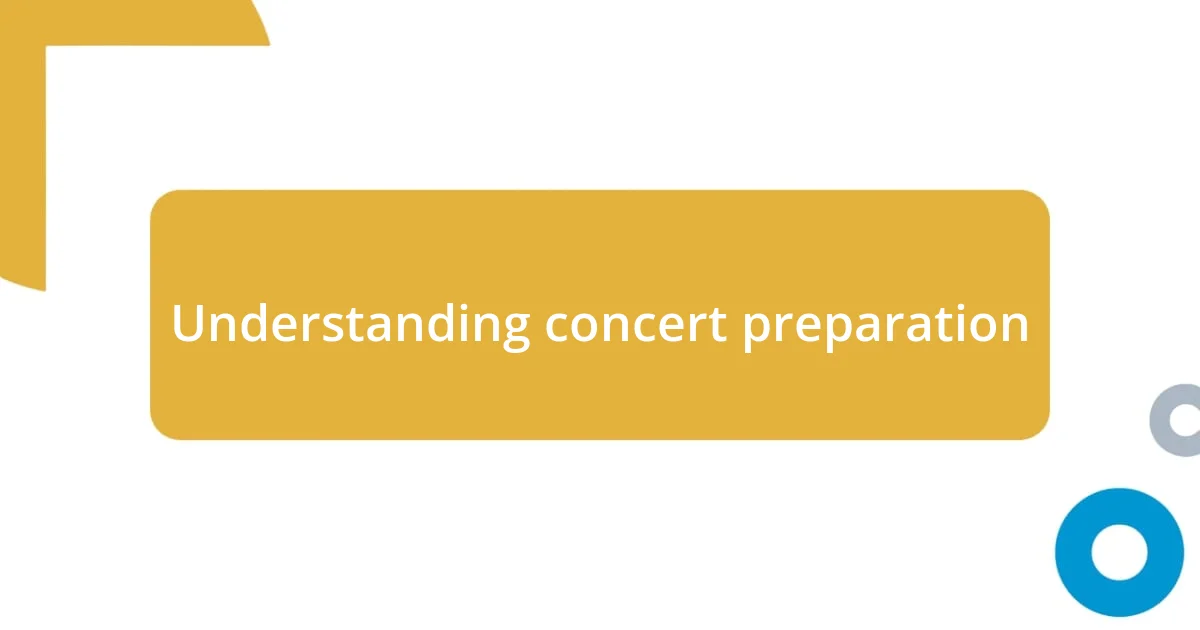
Understanding concert preparation
Preparing for a live concert is more than just packing your gear; it’s about embracing the whole experience. I remember my first concert, filled with a mix of excitement and nerves. It got me thinking—what actually goes into making that event successful?
One crucial aspect of concert preparation is the mental and emotional readiness. I recall a time when I felt way too anxious before hitting the stage. I learned that envisioning the performance and connecting with the audience can really transform that anxiety into anticipation. It raises the question—how do you mentally prepare for your big moment?
Logistics also play a significant role in how smooth the concert goes. From checking equipment and sound quality to ensuring travel plans are in order, each detail matters. I’ve found that on the day of a concert, sticking to a structured timeline can alleviate much of the chaos. Have you ever considered how a simple checklist could make or break your live performance experience?
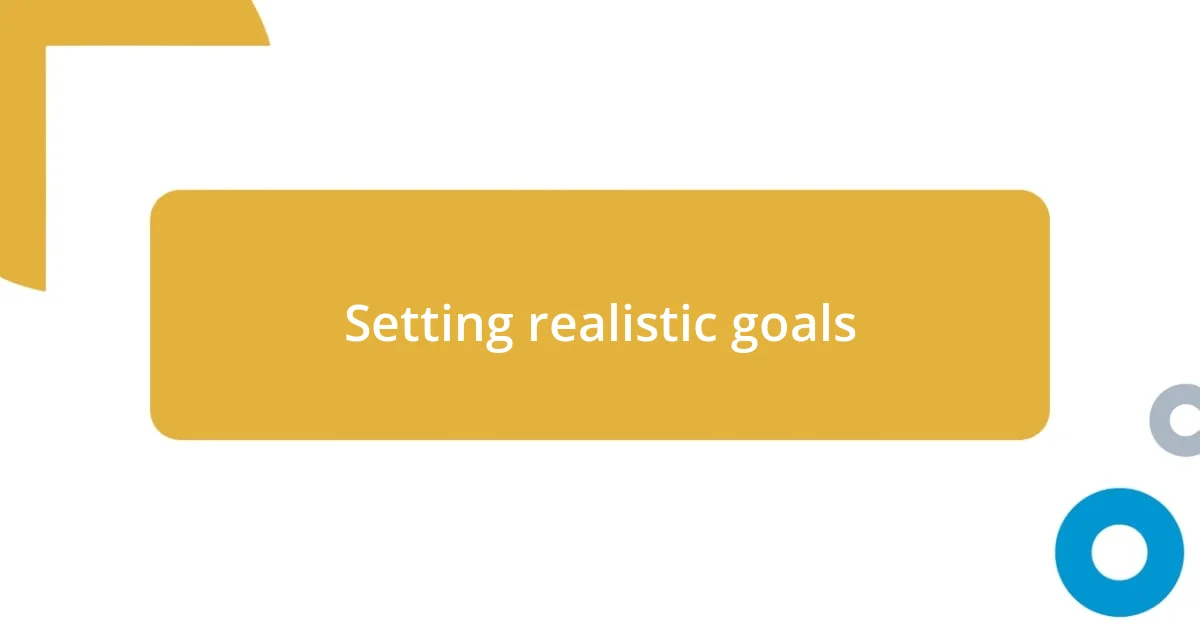
Setting realistic goals
Setting realistic goals is crucial for ensuring a successful live concert experience. When I first started performing, I remember setting overly ambitious targets, like wanting to have the crowd singing along to every song. Instead of an exhilarating experience, this often left me feeling disappointed. I’ve learned over time that aiming for smaller, manageable goals—like connecting with a handful of audience members or receiving positive feedback—can make a significant difference in my performance mindset.
Another key factor is to consider the venue. For instance, when I played in a cozy, intimate space versus a large festival stage, my expectations shifted dramatically. I found that setting goals based on the specific environment allowed me to adjust my approach—focusing on creating a personal connection with the audience in smaller venues while building up energy for larger crowds. It’s important to align your goals with the realities of your performance situation.
Lastly, flexibility in goal-setting cannot be understated. There was a time when I had a set list planned out meticulously, but the vibe of the crowd shifted when I started playing. Instead of stubbornly sticking to my original goals, I adapted and chose songs that resonated more with the audience that night. Embracing spontaneity can lead to unexpected and memorable moments, elevating the concert experience for both me and my audience.
| Type of Goal | Example |
|---|---|
| Performance Connection | Engaging with a few audience members |
| Venue Alignment | Adjusting set list based on venue size |
| Flexibility | Adapting to crowd energy during the concert |
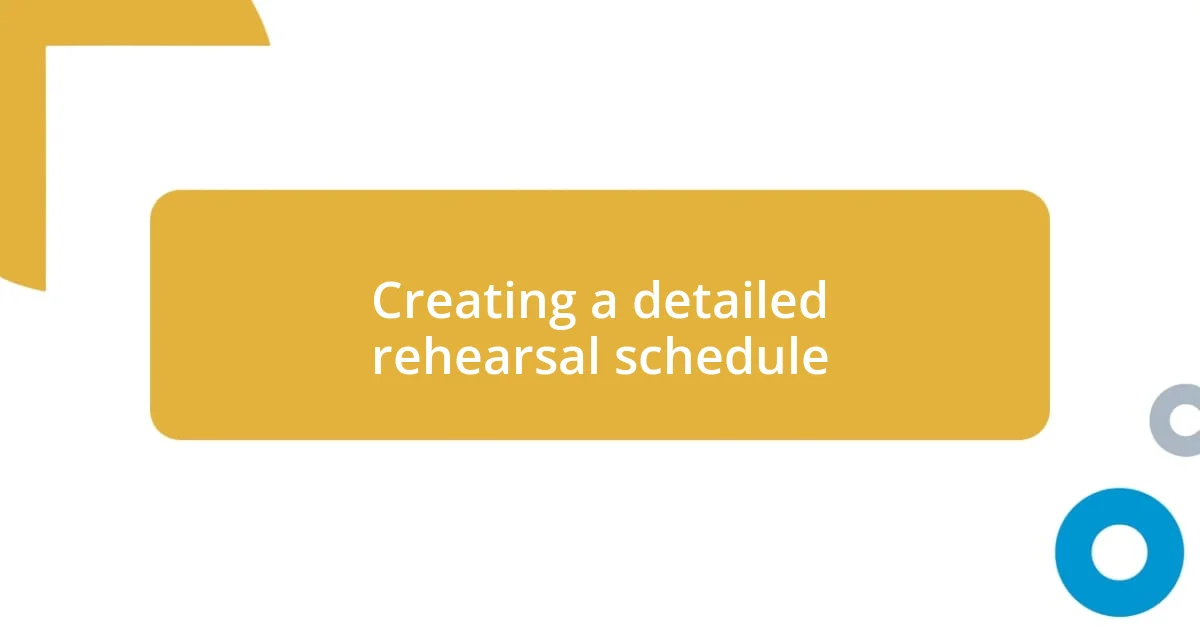
Creating a detailed rehearsal schedule
Creating a detailed rehearsal schedule is essential for fine-tuning performance elements. I remember a time when I didn’t prioritize rehearsals, thinking I could wing it. That led to a shaky performance that left me feeling frustrated. Now, I map out every session with clear objectives, which has fundamentally changed my approach.
To create an effective rehearsal schedule, consider the following:
- Set Clear Goals: Each rehearsal should focus on specific aspects, like vocal dynamics or stage presence.
- Time Allocation: Break down the rehearsal into segments, dedicating time to each song or element to avoid burnout.
- Regular Check-Ins: Schedule evaluations with bandmates or trusted peers to gauge progress and adjust focus as necessary.
- Flexibility is Key: Life happens, so allow room for adjustments and unexpected challenges.
- Record and Review: Listening back to rehearsals can help identify areas of improvement and reinforce what works well.
By embracing this structured approach, I have seen a significant boost in both confidence and performance quality. It’s all about creating a practice environment where creativity can flourish while still delivering a polished concert.
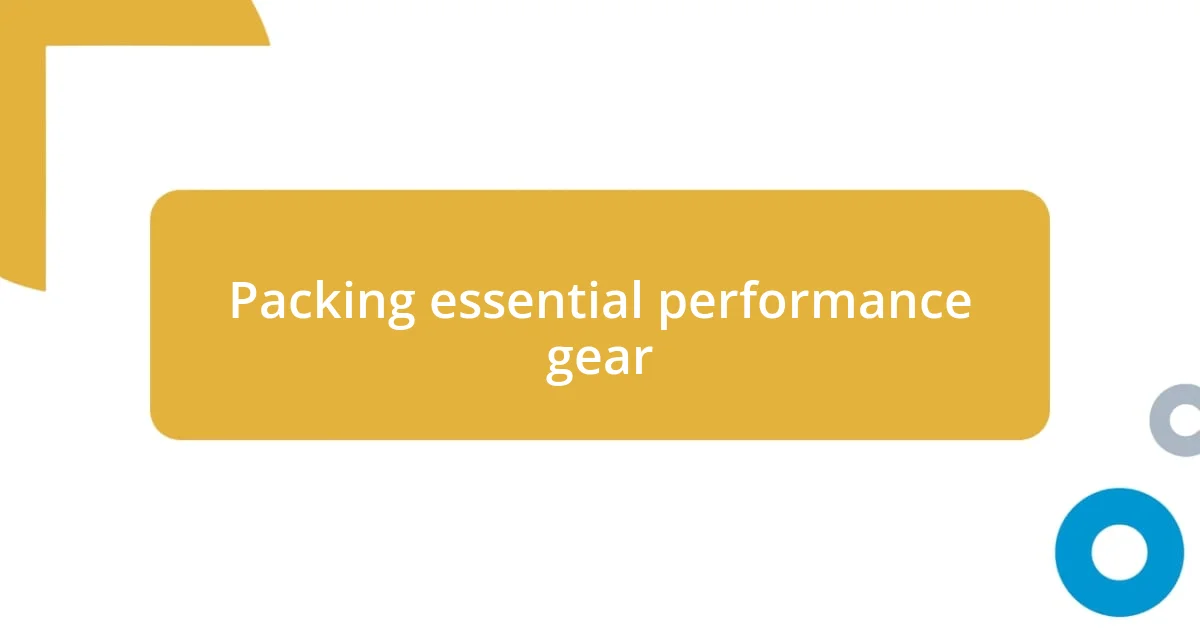
Packing essential performance gear
Packing essential performance gear can make or break your concert experience. I’ve been in situations where I forgot key items, like my favorite guitar pick or vocal warm-up essentials, and let me tell you, it’s a panic-inducing moment. Now, I keep a dedicated checklist that I meticulously follow before each performance. This not only reassures me that I have everything I need but also helps me create a sense of calm as I prepare to step on stage.
I remember one time arriving at a venue only to discover that I had left my special microphone at home. That mic was my trusted companion—it had a distinctive sound that I had tailored over countless gigs. Thankfully, I had a backup plan and a spare mic in my gear bag, but it taught me the importance of packing thoughtfully. Now, I always include backup items for crucial elements like microphones and cables because you never know what might happen.
As I pack for a live performance, I also reflect on the outfits I’ll wear. Choosing the right stage clothes is just as important as the instruments and tech gear. I find that wearing something that represents my style boosts my confidence on stage. Once, I wore a costume that I thought would stand out, but it ended up making me feel more like a performer than an artist. Since then, I’ve focused on outfits that allow me to express my personality genuinely while ensuring I feel comfortable moving around. After all, how can you connect with your audience when you’re preoccupied with your wardrobe?
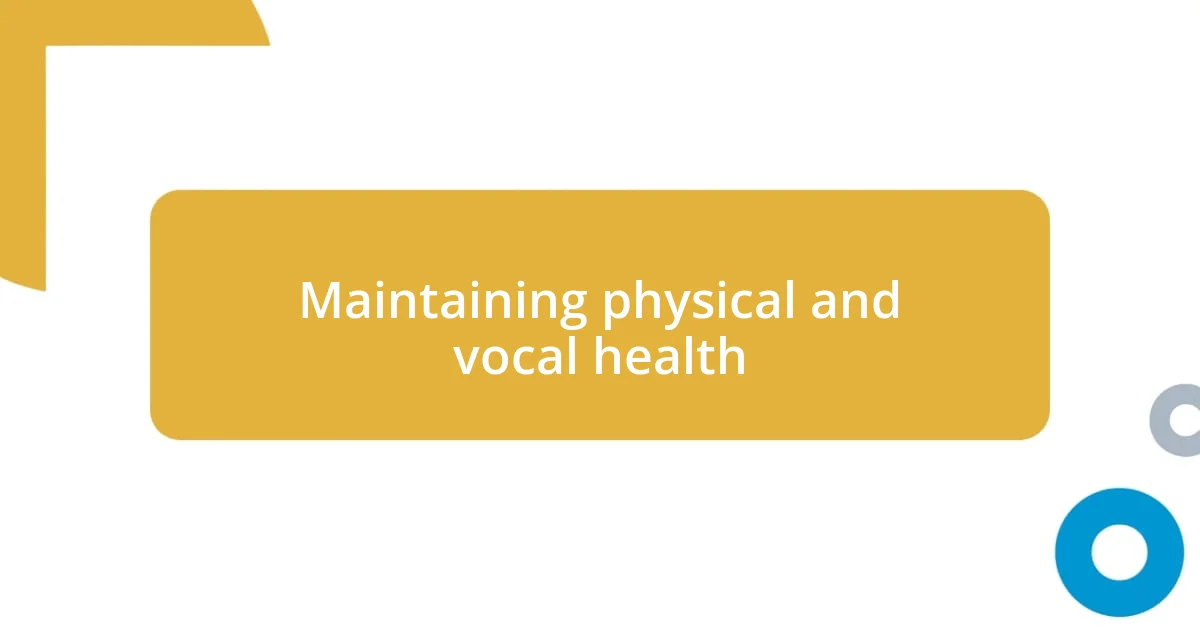
Maintaining physical and vocal health
Maintaining physical and vocal health is crucial for any performer heading into a live concert. Personally, I’ve always believed that my body and voice are my greatest instruments. To keep them in optimal condition, I make it a point to stay hydrated—nothing feels worse than stepping on stage with a scratchy throat. I often carry a water bottle with me and sip regularly to ensure my vocal cords are well-lubricated. Have you ever noticed how dry air or dehydration can sap your energy? Trust me, a well-hydrated voice is a happy voice!
I also integrate a warm-up routine into my preparation. It might sound a bit cliché, but those vocal exercises truly make a difference. I remember once, before a big gig, I skipped my usual warm-ups thinking, “I’ll be fine.” Let’s just say, I was anything but fine. My voice felt tight, and I struggled with high notes. Now, I never skip those essential warm-ups, dedicating at least 20 minutes to vocal exercises and breathing techniques. It’s not just about warming up the voice either—stretching and light cardio also help keep my body limber and ready to move.
Lastly, I’ve learned to listen to my body’s signals. If I’m feeling fatigued or under the weather, I prioritize rest and recovery. I recall an experience when I fought through a lingering cold, thinking the show must go on. While I performed, I could feel my body protesting, which limited my energy and enthusiasm. Now, I’ve realized that taking a day off to recharge can lead to a much more powerful and engaging performance later. Isn’t it a relief to know that honoring our physical health often translates to a better experience not just for us, but for the audience as well?
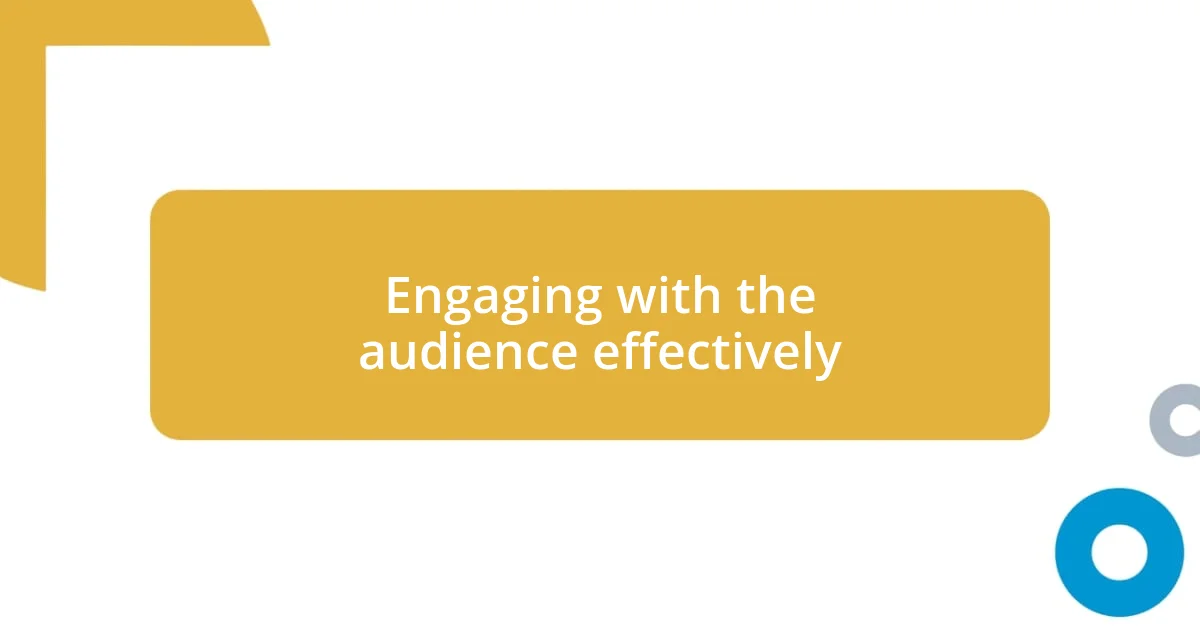
Engaging with the audience effectively
Engaging with the audience effectively is about creating a palpable connection that elevates the whole experience. Personally, I find that eye contact plays a monumental role in this. When I look into the crowd and make eye contact with individuals, it feels like I’m sharing a secret with them. It’s a simple act, yet it transforms the performance from a one-way street to a dialogue. Have you ever felt that rush when you lock eyes with someone in the audience? It creates a sense of unity and draws them into the moment with you.
I also embrace the power of storytelling during my performances. Sharing a brief anecdote or insight about a song’s backstory not only humanizes the experience but also makes the audience feel included in something special. For example, while performing a ballad once, I shared how it was inspired by my own heartbreak. The response was overwhelming; people nodded, smiled, and I could see their emotions resonating with mine. It was a reminder that we’re all connected through these shared experiences, amplifying the emotional intensity of the concert.
Another tactic that has proven effective is to invite audience participation. Often, I’ll throw in a sing-along moment or encourage the crowd to clap along with the beat. I vividly recall a gig where I prompted everyone to repeat a simple line. The sheer joy in their faces, echoing back to me, was electrifying. It’s incredible how small interactions like this can make everyone feel like a part of something bigger. doesn’t it spark a sense of joy when we come together in such a lively manner? Engaging your audience transforms passive listeners into active participants, making the concert a shared experience.
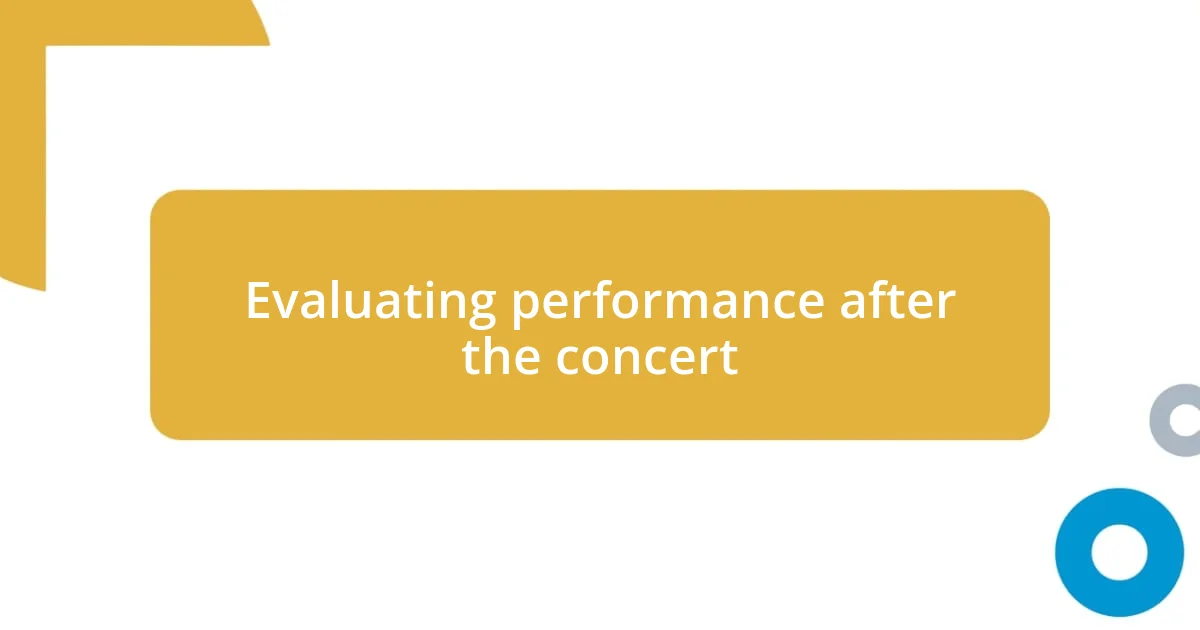
Evaluating performance after the concert
Evaluating performance after the concert is a crucial step in my growth as a musician. I always take some time to reflect on how I felt on stage—what moments sparkled and which parts fell flat. Was my energy consistent throughout the show? I remember a time when I nailed my high-energy songs, but during the slower tracks, I noticed I wasn’t connecting as deeply. That realization pushed me to think about how I can infuse more emotion into those quieter moments next time.
I also find value in recording my performances. Listening to playback offers me insights I might miss in the heat of the moment. There have been instances when I’ve heard my voice crack or felt a lack of passion in certain sections—something I couldn’t catch while performing. This kind of feedback is vital for my improvement. Have you ever recorded yourself and been surprised at what you discover? It can be eye-opening and even a little hard to swallow, but it’s incredibly helpful.
Finally, connecting with my team post-performance helps ground my experience. I often chat with my bandmates about what worked and what didn’t. I remember one gig, where we all felt we had a solid show, but one of my guitarists pointed out a few missed cues that I hadn’t noticed. That conversation reminded me that evaluation isn’t just about my performance; it’s a team effort. How do you evaluate your performances after the fact? Engaging with others provides a richer perspective and helps us grow collectively.












